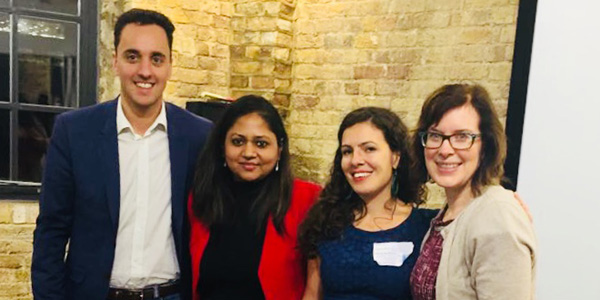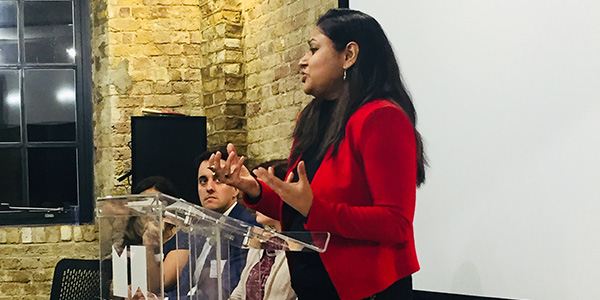Let us know what type of content you'd like to see more of. Fill out our three question survey.
3 Key Takeaways From Our London Digital Inclusion Event
Dec 4, 2017
Earlier this week, we were joined by Alex Tyers of Panoply Digital, Saloni Korlimarla of the Cherie Blair Foundation (CBF) for Women, and Guillaume Touchard from the GSM Association (GSMA)’s Connected Society Team at the delightful Makers Academy space in Shoreditch, United Kingdom, to discuss, debate, and engage around the challenges and opportunities for increasing digital inclusion and access.
Given that nearly 70 percent of people living below the poverty line in developing countries own a mobile phone, continuing to push for broader reach and inclusion presents a clear opportunity to reach new people with access to relevant services and content. Increasing access is only possible with infrastructure such as mobile broadband coverage and the associated policy and regulatory frameworks in place. Event attendees talked about how such access would benefit women, young people, disabled, rural, and other groups—as long as digital and traditional literacy are supported. Data and evidence of impact are critical pieces of the inclusion puzzle as well.

Panelists, from left, included Guillaume Touchard, Saloni Korlimarla, Alexandra Tyers, and Krista Baptista.
The evening included participants from the London ICT4D Meetup group as well as people interested in engaging in the international development and inclusion space. If you were not able to make the event, we hope to see you in early 2018 at the next London ICT4D happening. In the meantime, below are three key takeaways from the event.
1. Tailored solutions: Saloni discussed the importance of matching needs, available technologies, and cultural issues when designing solutions—with a particular focus on women. Simple adjustments such as having women mobile phone agents at kiosks can exponentially increase uptake and digital literacy among women. Saloni gave an example from a CBF project in India, with the VodaPhone Foundation, where a network of rural saleswomen (RudiBens) were able to order stock via text message, generate reports on their simple feature phones, and access information essential to running their businesses, increasing revenue by up to three times. Knowing your audience and pushing to understand their motivations is critical to effective integration of digital tools.

Saloni Korlimarla discusses her work at the Cherie Blair Foundation.
2. Data and evidence—disaggregate, disaggregate, disaggregate: We’ve got to push our partners, donors, and country governments to disaggregate their data by gender in order to really be able to assess the effectiveness of interventions, drill down into impacts, and demonstrate to the skeptics and new private sector partners where the opportunities and gaps are! Drawing on her work co-authoring the recent Gender and ICT Toolkit, Alex really honed in on the challenges of not having accurate data on women’s use of mobile phones by country and how it affects our ability to design activities and advocate for real change.
3. Infra-sharing should be the future: Guillaume presented a compelling case to connect people based on the possibilities of economic gains. He also talked about wasted investments; for example, if multiple telecoms each construct their own cell towers right next to one another, resources are wasted. By combining infrastructure, companies can each reduce the net investment and therefore the value proposition for extending access via cell towers goes up.
In the end, Saloni, Alex, and Guillaume each looked at inclusion from a different perspective. We need each of these perspectives as well as those of the people in the countries where we work, to truly change the story of who has access and who doesn’t.